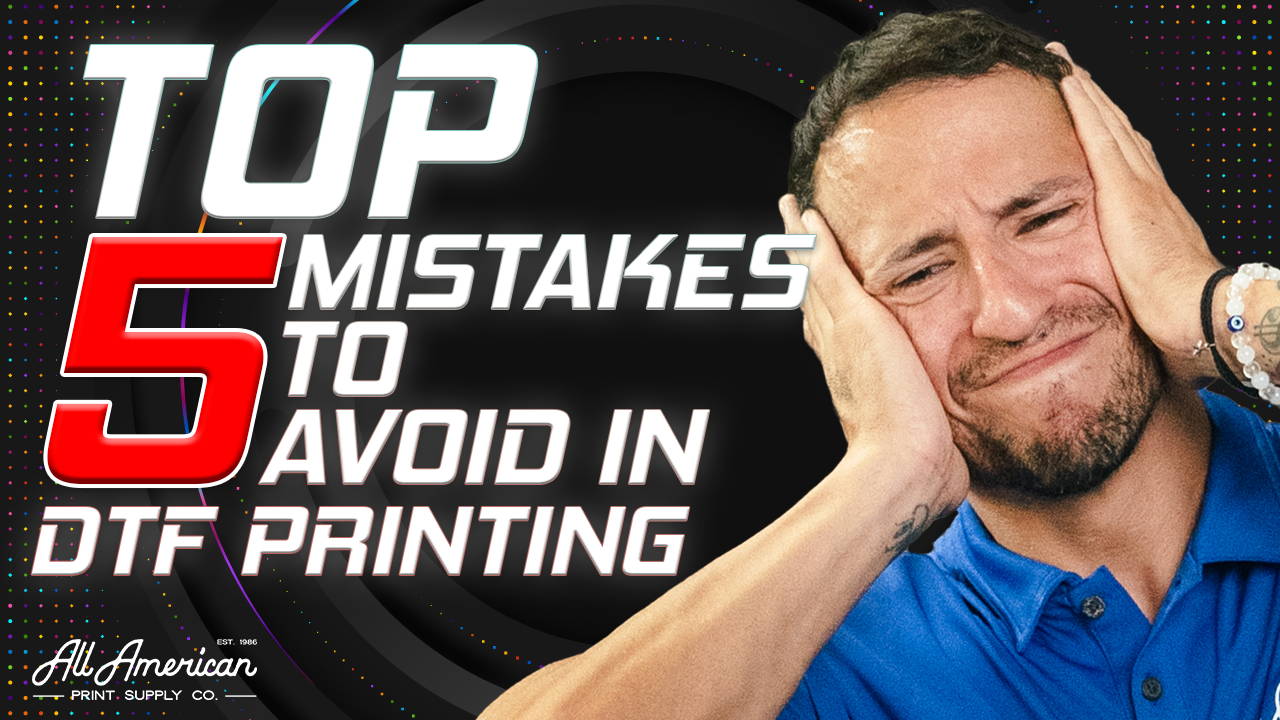BE CAUTION!
Top 5 mistakes to avoid in dtf printing

"Experience is the name everyone gives to his mistakes."
It’s like the classic hip hop song goes, “more printing, more problems.” That’s what The Notorious B.I.G. said, right? Well, in any case, we are here to help. For those experienced already in direct to film or maybe just starting out with DTF, we have put together a top 5 list of the most common mistakes made with direct to film and how to avoid them. We have been running direct to film longer than almost any other company in our industry, and there has been a lot we have learned along the way. As your number one source for all things DTF, you can always count on us to keep you up to date and armed with not only the best printing equipment and supplies but also the expert insight on how to be successful.
DYE MIGRATION
Have you ever printed a transfer or image onto material where you were able to see a hint of the fabric color showing through the design? I would bet the fabric color was red. Or made up of a pattern. If you have experienced this, then you know firsthand what DYE MIGRATION is. The example I like to always give when explaining dye migration is there are no blue sheep. There are no red sheep - so many of the color materials we work with are dyed through a chemical process to become the color we see. What happens sometimes under high heat (as low as 265°F) is that chemical dye can reach and literally move or migrate to the transfer area. This will be most prevalent in reds, material that is a pattern, and synthetic material such as polyester. The best fixes for this would be black DTF powder, which is a proven dye blocker OR if you have a DTF Station direct to film printer, you can also increase the amount of white printed. Or a higher-grade blank garment.
STATIC
Static electricity is the result of an imbalance between negative and positive charges in an object. These charges can build upon the surface of an object until they find a way to be released or discharged - WHAT DOES THIS HAVE TO DO WITH DIRECT TO FILM? Have you ever seen what appears to be powder AROUND the image on the printed transfer? Ya know where it SHOULD NOT BE? This is due to static. Any media printer can run into static through friction; this is normal - with direct to film, this can mean problems. Those little dots around the image on the transfer can actually apply to your garments along with your image which we do not want. The best fix is to use better DTF film. As all films are not created equal, lesser manufacturers may not be able to consistently or adequately apply the anti-static layer to each batch resulting in static-related powder issues.
DYE MIGRATION
Ok, this can be a big one. You don’t want to land that huge account and not be able to deliver on the product when the client needs a close match - that’s color accuracy. How close are the printed transfers to the actual file? This has happened to me before - you send your high-resolution graphics to the printer and it just looks a little off. Certain colors can be difficult to achieve, but it is doable. The fix would again be a better film: the ink-absorbing layer is important to get your printed designs onto the fabric accurately. If you are unsure of your supplier, cold peel films typically have more ink-absorbing layer than a hot peel. What can also be of assistance is upgrading your RIP software. Printing with queues profiled for your specific film will produce the right amount of ink at the proper saturation.
HUMIDITY
The amount of moisture in the air (HUMIDITY) can have a direct correlation with your printer’s performance. Dry, desert climates can cause the printer to dry the printer out and create head clogs causing bad printing. Too much moisture in the air can affect the performance of the DTF powder. Depending on your environment, an in-room humidifier or dehumidifier can help maintain the ideal amount of moisture in the air that would be within single digits of 55%. This optimum amount of humidity will keep the printer comfortable and prevent frequent maintenance-related production interruptions.
TEMPERATURE
In a perfect world, the DTF printer is kept indoors, in a climate-controlled, clean environment. Overheating can become an issue for any electronic devices and when it comes to your direct to film printer overheating can result in internal component failure, breaking, or becoming potentially hazardous. Some models may even have features to prevent overheating-related damage by shutting down after prolonged operation under high heat. A good rule of thumb is if YOU are comfortable your printer is comfortable. Maintaining an operating temperature of between 60-75 degrees Fahrenheit through air conditioning will keep everything running smoothly and safely.
Meet our author
Estevan Romero
Brand Marketing Lead
Esteven Romero began making YouTube videos back in 2017 to help new business owners learn how to use their products and grow their operation.
He has been featured in many companies content such as Siser North America, Key Print Co and more. He has been featured as a speaker/presenter nationwide across the tradeshow circuit sharing information and insight to the print community audience and brings 13+ years of experience to the table.
You can meet Estevan and more of the friendly All American Print Supply Co team by visiting the company live events calendar and our YouTube channel.





